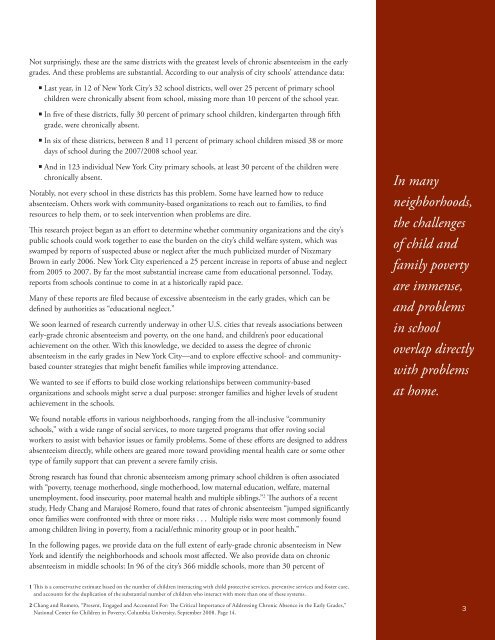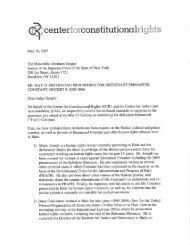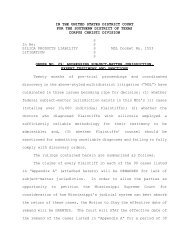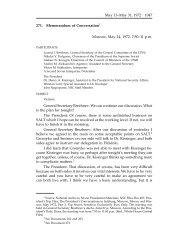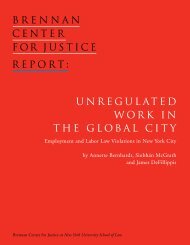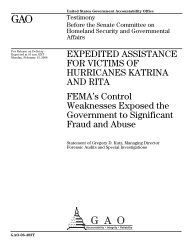Strengthening Schools by Strengthening Families
Strengthening Schools by Strengthening Families
Strengthening Schools by Strengthening Families
Create successful ePaper yourself
Turn your PDF publications into a flip-book with our unique Google optimized e-Paper software.
Not surprisingly, these are the same districts with the greatest levels of chronic absenteeism in the early<br />
grades. And these problems are substantial. According to our analysis of city schools’ attendance data:<br />
■■<br />
Last year, in 12 of New York City’s 32 school districts, well over 25 percent of primary school<br />
children were chronically absent from school, missing more than 10 percent of the school year.<br />
■■<br />
In five of these districts, fully 30 percent of primary school children, kindergarten through fifth<br />
grade, were chronically absent.<br />
■■<br />
In six of these districts, between 8 and 11 percent of primary school children missed 38 or more<br />
days of school during the 2007/2008 school year.<br />
■■<br />
And in 123 individual New York City primary schools, at least 30 percent of the children were<br />
chronically absent.<br />
Notably, not every school in these districts has this problem. Some have learned how to reduce<br />
absenteeism. Others work with community-based organizations to reach out to families, to find<br />
resources to help them, or to seek intervention when problems are dire.<br />
This research project began as an effort to determine whether community organizations and the city’s<br />
public schools could work together to ease the burden on the city’s child welfare system, which was<br />
swamped <strong>by</strong> reports of suspected abuse or neglect after the much publicized murder of Nixzmary<br />
Brown in early 2006. New York City experienced a 25 percent increase in reports of abuse and neglect<br />
from 2005 to 2007. By far the most substantial increase came from educational personnel. Today,<br />
reports from schools continue to come in at a historically rapid pace.<br />
Many of these reports are filed because of excessive absenteeism in the early grades, which can be<br />
defined <strong>by</strong> authorities as “educational neglect.”<br />
We soon learned of research currently underway in other U.S. cities that reveals associations between<br />
early-grade chronic absenteeism and poverty, on the one hand, and children’s poor educational<br />
achievement on the other. With this knowledge, we decided to assess the degree of chronic<br />
absenteeism in the early grades in New York City—and to explore effective school- and communitybased<br />
counter strategies that might benefit families while improving attendance.<br />
We wanted to see if efforts to build close working relationships between community-based<br />
organizations and schools might serve a dual purpose: stronger families and higher levels of student<br />
achievement in the schools.<br />
We found notable efforts in various neighborhoods, ranging from the all-inclusive “community<br />
schools,” with a wide range of social services, to more targeted programs that offer roving social<br />
workers to assist with behavior issues or family problems. Some of these efforts are designed to address<br />
absenteeism directly, while others are geared more toward providing mental health care or some other<br />
type of family support that can prevent a severe family crisis.<br />
Strong research has found that chronic absenteeism among primary school children is often associated<br />
with “poverty, teenage motherhood, single motherhood, low maternal education, welfare, maternal<br />
unemployment, food insecurity, poor maternal health and multiple siblings.” 2 The authors of a recent<br />
study, Hedy Chang and Marajosé Romero, found that rates of chronic absenteeism “jumped significantly<br />
once families were confronted with three or more risks . . . Multiple risks were most commonly found<br />
among children living in poverty, from a racial/ethnic minority group or in poor health.”<br />
In the following pages, we provide data on the full extent of early-grade chronic absenteeism in New<br />
York and identify the neighborhoods and schools most affected. We also provide data on chronic<br />
absenteeism in middle schools: In 96 of the city’s 366 middle schools, more than 30 percent of<br />
1 This is a conservative estimate based on the number of children interacting with child protective services, preventive services and foster care,<br />
and accounts for the duplication of the substantial number of children who interact with more than one of these systems.<br />
2 Chang and Romero, “Present, Engaged and Accounted For: The Critical Importance of Addressing Chronic Absence in the Early Grades,”<br />
National Center for Children in Poverty, Columbia University, September 2008. Page 14.<br />
In many<br />
neighborhoods,<br />
the challenges<br />
of child and<br />
family poverty<br />
are immense,<br />
and problems<br />
in school<br />
overlap directly<br />
with problems<br />
at home.<br />
3


